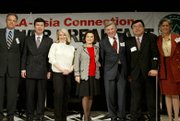KFWB Hosts Power Breakfast at CMC
International trade is the engine that keeps the Southern California economy chugging along, and the Los Angeles apparel industry contributes a major share.
Clothing, coming right after furniture and right ahead of electronic products, is the second most imported item entering the Port of Los Angeles.
With telecommunications growing and trade barriers shrinking, Los Angeles will only gain importance as a major transportation hub for trade to Asia, and the city’s ascendancy will generate local jobs.
“We are currently responsible for about 43 percent of the consumer goods coming into the United States,” said Larry A. Keller, executive director of the Port of Los Angeles. “Our interests right now are growth [at the port] and how to handle it. We realize we have to move these goods to other parts of the country. Infrastructure, velocity and making sure goods arrive on time are extremely important. We are working on multi-shifting so goods can continue to move and that there is enough labor.”
Keller was one of six people who spoke on a panel about the Los Angeles–Asia connection on Jan. 29 at the California Market Center in Los Angeles. About 400 people attended the power breakfast, sponsored by radio station KFWB-AM, at the CMC’s fashion theater. Other panel members included Charles Woo, co-founder and chief executive of Los Angeles toy company Megatoys Inc.; David Josephson, Western regional director of the Export-Import Bank of the United States; Mary Delmege, director of the Pacific Southwest region for U.S. Export Assistance Centers; Ilse Metchek, executive director of the California Fashion Association; and James Flanigan, senior economics editor for the Los Angeles Times. KFWB business reporter Laura Gregory moderated the panel.
Panelists discussed how Asia is the No. 1 trading partner for the United States.
“In 2002, as a bloc, Asia purchased about $200 billion of U.S. exports out of $700 billion in goods exported by the U.S.,” said Josephson of the Export-Import Bank. “The ties with Europe are old. I think Asia is the new world for international business.”
Apparel is one of the strongest ties Southern California has to Asia right now, said panelists. That connection will only grow after apparel and textile quotas disappear in 2005 among World Trade Organization members.
“Los Angeles is the No. 1 distributor of apparel in the U.S., not New York,” said Metchek of the California Fashion Association, a nonprofit group that helps build Southern California’s apparel and textile businesses. Much of that apparel is designed in Los Angeles and manufactured in Asia, she added.
“But as an industry, we are given credit statistically [in U.S. export figures] for our design ideas,” Metchek said. “We export ideas.hellip;We think there should be some credit for this.”
One of the concerns discussed was patent infringement and counterfeiting of U.S.-designed apparel in Asia and other countries.
Flanigan, who often writes about international trade, noted that as countries such as China and India grow more sophisticated and develop their own ideas, they will begin to heed international concerns about patent infringements and illegal knockoffs.
“Once that happens, counterfeiting will spawn a home-grown industry and patent law and product liability law will be developed,” he said. “But this is a long-term process.”
For the apparel industry, knockoffs can sometimes be beneficial. Metchek pointed to Oshkosh B’Gosh Inc., which struggled financially until Oshkosh imitations popped up in Asia and generated a renewed interest in the company’s apparel.
“That helped establish the brand worldwide,” she said. “But the competitive advantage we have in Los Angeles is that we are not mired in twice-a-year buying cycles like they are in Europe and Asia and South America. We have five seasons and 10 product lines. I don’t know of any industry that invents itself every 10 weeks. By the time it is copied, our season is over.”
Los Angeles Mayor James Hahn made a guest appearance, telling attendees public safety is one of the top issues on his agenda. In trimming the budget, the city has cut 400 administrative jobs but has added more than 230 positions in the police department, he said.
“People will not invest in areas they don’t believe are safe,” Hahn said. “This is going to be my priority— to continue to make Los Angeles safer to bring in the investment and the jobs that our people deserve.”
—Deborah Belgum























